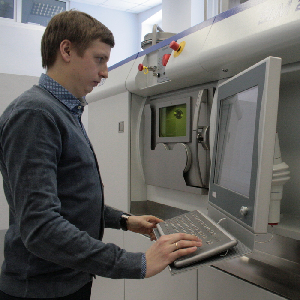
English > News
SSAU scientists are involved in the creation of a special 3D-printer for the aerospace industry
15.05.2015, 14:11
Scientists of Samara State Aerospace University are involved in the Project of St. Petersburg Polytechnic University.
The works are carried out within the framework of the Federal Target Program “Research and Development in Priority Areas of Development of the Russian Scientific and Technological Complex for 2014 - 2020 years”.
Under the contest terms, after production of the printer it will print a valid sample of component part, which will be established on the operated engine after testing.
JSC “Kuznetsov” acting as the industrial partner of the project will be the first user of the new printer. The enterprise has to receive a finished sample of the “printed” component part as late as in 2017. Afterwards it will be possible to organize 3D-printing of products in industrial-scale volumes.
It is noteworthy that the first domestic 3D-printer for direct metal fabrication will be much different from the traditional 3D-printing technology. The improved material supply system will be characteristic property of the Russian device. The existing foreign devices working on the selective laser melting technology perform relatively long task by consistent model baking - layer by layer.
In the Russian development a laser light is applied to the feed point of sintered powder. Due to this, the printer productivity is increased in several times. This is particularly topical for the manufacture of large parts of irregular shape.
As co-executor SSAU develops nozzle and optical system for monitoring of powder distributing for printing. Nozzle is a kind of valve, where the powder is fed to the printer. It includes a cooling loop and the gas supply system into the fusion zone.
According to Vitaliy Smelov, the Head of SSAU Laboratory of Additive Technologies, Russian version of the nozzle allows to bake the powder right in the place of supply to part profile. In this regard Samara scientists also develop an optical system for filing and calculation of the selective melting of the powder into the fusion zone.
At the end of 2015 a technological nozzle head model should be made and the first fusing sample meeting the highest quality requirements applicable to the aviation and space technology should be received.
The created 3D-printer is designed to print large components and aircraft engine components, made from heat-resistant and refractory metals - bearings and combustion chambers.
In the long view the new high-performance printer will be able to replace outdated and costly technologies in engine building- parts casting and forming.
In addition, in the course of the project implementation it is scheduled to perform physical simulation of renewal processes for worn or damaged parts of the aircraft engine. It is also planned to conduct experimental researches and evaluation of the complex of physical and mechanical properties of the obtained structures of metallic materials. On the basis of additive technologies a failed part can be recovered and returned to the work that will allow extending the life and reducing the cost of machinery maintenance.
The research participants expect that in five years the Russian devices for direct metal fabrication will be further developed to become more compact and can be used in outer space, including the International Space Station.
.JPG)
.JPG)









